
|

|
The Role of Women in Viking Society
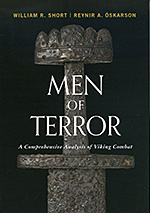 |
Some of the text presented on this page may be out-of-date. Until we find time to make the needed updates, we encourage readers to look at this topic as it is presented in our new book, Men of Terror, available now from your favorite book seller. |
|
Although our sources of information are limited, it's clear that the roles of men and women in Norse society were quite distinct. Norse society was male dominated. Each gender had a set of expected behaviors, and that line could not be crossed with impunity. I think it just as unlikely that a man would weave cloth as that a woman would participate in a Viking raid. Women did not participate in trading or raiding parties (although they clearly participated in journeys of exploration and settlement to places such as Iceland and Vínland). Women's responsibilities were clearly defined to be domestic. Members of either sex who crossed the gender line were, at very least, ostracized by society. Some cross-gender behaviors were strictly prohibited by law. The medieval Icelandic lawbook Grágás (K 254) prohibits women from wearing men's clothes, from cutting their hair short, or from carrying weapons. |
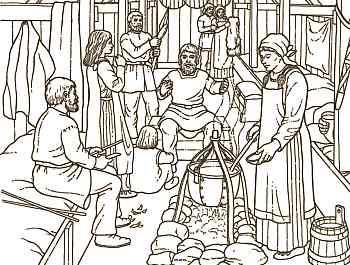 |
On one hand, a woman was, by law, under the authority of her husband or father. She had only limited freedom to dispose of property belonging to her. She was prohibited from participating in most political or governmental activities. She could not be a gođi (chieftain). She could not be a judge. She could not be a witness. She could not speak at ţing (assemblies).
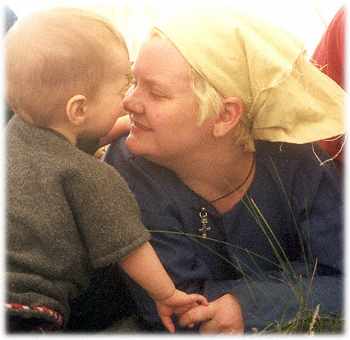 |
On the other hand, women were respected in Norse society and had great freedom, especially when compared to other European societies of that era. They managed the finances of the family. They ran the farm in their husband's absence. In widowhood, they could be rich and important landowners. The law protected women from a wide range of unwanted attention. Grágás (K 155) lists penalties for offences ranging from kissing to intercourse. The first few chapters of Laxdćla saga tell the story of Unnur djúpúđga (the Deep Minded), who was already widowed when she left Norway for Scotland with her father and son. When they, too, were killed, she felt that she had to leave Scotland and join the remainder of her family in Iceland. She arranged for a ship to be built, gathered her family and followers, and sailed for Iceland. Once in Iceland, she claimed land, settled there, arranged for a farm to be built, and then ran the farm. Over the years, she gave away portions of her land holdings to supporters, and arranged marriages for her daughters. In sum, Unnur took over all the responsibilities normally held by the husband. When she died, she was laid in a ship in a burial mound, an honor normally reserved only for the most powerful and wealthy men. |
|
The day to day responsibilities of women included: food preparation and serving; housekeeping and laundry; child care; milking and dairy chores; and clothes making, from spinning and weaving to cutting and sewing. The dividing line between men's and women's responsibilities typically was located at the doorway to the house; women were in charge of everything indoors while everything outdoors was the responsibility of the men. Most of the Icelandic family sagas are about men and probably were written by men. Women tend to play only minor roles, but those roles are varied. In general, the female characters are strong. The female characters in the sagas are praised for beauty, but more frequently for their wisdom. Many of the character traits regarded as positive in men (such as a sense of honor, courage, and a strong will) are also regarded as positive traits in women. Laxdćla saga covers over a century in the lives of families living in the Dalir region around Breiđafjöđur in western Iceland. However, much of the saga focuses on the life of Guđrún Ósvífsdóttir and her various loves, and the story might be described as a soap opera. As an old woman, Guđrún was asked by her son which man she loved most. Guđrún answered (chapter 78), "I was worst to him whom I loved most." The handling of the subject matter and the moral undertones of the saga have convinced some scholars that the author of this saga was a woman. |
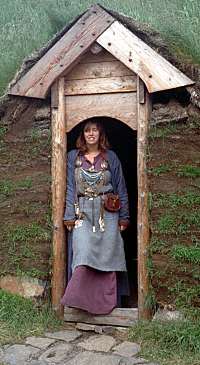 |
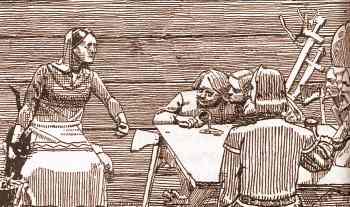 |
One common role of women in the sagas is as an inciter. The goading scene is a classic in the saga literature. Women frequently goaded men to act, to take revenge, when the men might otherwise have been content to do nothing. The women are much harder than the men, even more eager to protect the family's honor. Perhaps this is due to the woman's passive role, which prevented her from acting herself. In chapter 116 of Brennu-Njáls saga, Hildigunnur incited her uncle Flosi to avenge the killing of her husband Höskuldr by flinging her husband's bloody cloak onto Flosi's shoulders. Clotted blood from the cloak rained down on Flosi. He responded, "Cold are the counsels of women." Flosi later took revenge for Höskuldr's death by burning Njáll and his family in their home. |
In chapter 48 of Laxdćla saga, Guđrún, the wife of Bolli, incited her husband and her brothers to take revenge on Kjartan, Bolli's beloved foster-brother. For Bolli to kill his foster-brother would be a despicable act, but Guđrún pulled out all the stops, saying to the men:
"With your temperament, you'd have made some farmer a good group of daughters, fit to do no one any good or any harm. After all the abuse and shame Kjartan has heaped upon you, you don't let it disturb your sleep while he goes riding by under your very noses, with only one other man to accompany him. Such men have no better memory than a pig. There's not much chance you'll ever dare to make a move against Kjartan at home if you won't even stand up to him now, when he only has one or two others to back him up. The lot of you just sit here at home, making much of yourselves, and one could only wish there were fewer of you."
A woman might use the threat of divorce as a means to goad her husband into action. Divorce was relatively easy and could result in severe financial burdens on the husband.
|
Women sometimes took the opposite tack, moderating or stopping fights in progress. This was sometimes accomplished by throwing clothing on the men's weapons as they fought, for example in chapter 18 of Vopnfirđinga saga. Ţorkell chased Bjarni to Eyvindarstađir, and began to fight. (The farm as it appears today is shown to the right.) Eyvindur learned of the fight near his hayfield wall. While the women threw clothing on the men's weapons, Eyvindur went between the men with a wooden pole to separate them. |
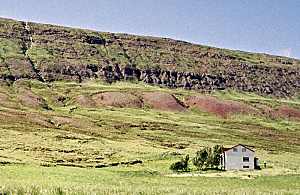 |
Women are shown being skilled in magic. In general, this was considered evil, such as the magic used by Ţuríđur against Grettir in Grettis saga. Women were sometimes killed for using magic. Working magic was considered womanly. It would be unseemly for a man to use magic or to benefit from magic. Ţorbjörn was thought to be base and cowardly by taking advantage of Ţuríđur's magic to kill Grettir. But when the magic was used for good, a woman was admired, such as Ţorbjörg in Eiríks saga rauđa. During a time of extreme famine, she foretold the fate of the community at a feast in her honor.
Among the weaker female characters in the sagas are old foster-mothers, maidservants, and gossips.
|
Unwanted attention from a man towards a woman was forbidden in Norse society. In chapter 24 of Kormáks saga, it is said that while walking in the street, Kormákr saw Steingerđr sitting. He sat down next to her, talked to her, and then gave her four unwanted kisses. Ţorvaldr saw this and drew his sword, but other women intervened before he could strike. Kormákr was fined two ounces of gold, a very substantial sum of money. Later, while at sea, Kormákr sailed his ship close enough to Ţorvald's ship to strike at Ţorvaldr with his tiller. Ţorvaldr fell, stunned. Steingerđr, who was on board Ţorvald's ship, took the helm and steered broadside into Kormák's ship, capsizing it. Nor did women tolerate unwanted attention. Króka-Refs saga (ch.16) says that Grani came to the home of Helga one day, knowing that her husband Refur and her sons were all attending a ţing that day. He said he wanted to buy a woman, and Helga told him to go elsewhere. When he grabbed her, she sprang up and defended herself, and the struggle became a wrestling match. Grani saw Helga's husband approaching and tore himself free, but Refur chased after him and killed him. |
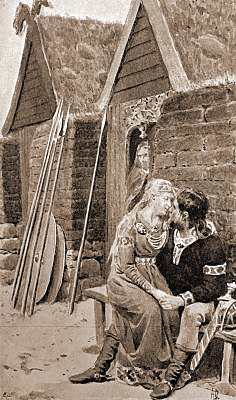 |
It was considered shameful in the extreme to harm a woman, and examples in the sagas of such violence are rare. In chapter 48 of Brennu-Njáls saga, Gunnar, in a fit of rage, slapped his wife Hallgerđur in the face. He did this when he discovered his wife had stolen food from a nearby farm during a famine. (Theft was abhorrent in Norse society.) Hallgerđur said she would remember that slap and pay him back.
Some years later, in chapter 77, Gunnar was attacked in his home by vengeance seekers. He kept the attack party at bay with a shower of arrows from his bow. When his bow string was cut by one of the attackers, he asked Hallgerđr for two locks of her hair in order to make a new one.
"Does anything depend on it?" she asked.
"My life," replied Gunnar.
"Then I remind you of the slap you once gave me," and she refused to give him the hair.
"Each has his own way of earning fame," said Gunnar.
Gunnar was eventually overcome by the attackers and killed.
Women were excluded from these kinds of attacks on a household. It was a grave dishonor for a man to injure a woman, even accidentally, in an attack on a household. And if, for instance, a house were going to be burned to kill the occupants, women and children were allowed to leave without injury. In chapter 129 of Brennu-Njáls saga, Flosi invited the women and children to leave Njál's house after it had been set afire. Many chose to leave, but Njál's wife Bergţóra refused, saying that in marriage, she promised to share the same fate as her husband. They both perished in the fire.
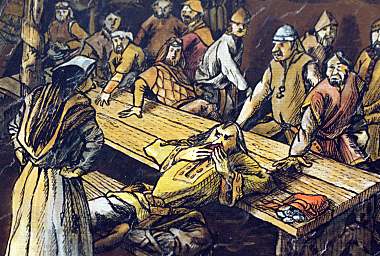 |
Another example comes from chapter 32 of Gísla saga Súrssonar. Eyjólfur, along with eleven of his men, met with Auđur to convince her to betray the location of her outlaw husband, Gísli, in exchange for money. Auđur took the purse full of silver, pretending to accept his offer. She struck Eyjólfur across the face with the purse, drawing blood, which was a mortal insult. Auđur said, "Take this now for your cowardice and your shame." Eyjólfur commanded his men to kill her on the spot, but Hávarđur stood up to him, saying, "Our expedition has gone badly enough without this disgraceful deed." Eyjólfur conceded, and Auđur was left unharmed. The photo to the right shows the ruins of Auđur's farm at Geirţjófsfjörđur, where this event took place. |
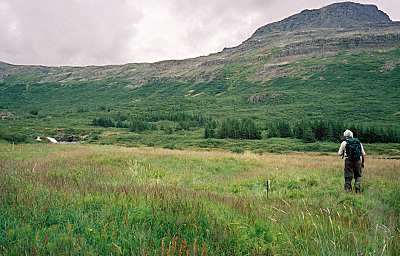 |
Even mild or playful violence against women was unacceptable. When one of Helgi's men threw a snowball at Ţórdís (Droplaugarsona saga chapter 10), Helgi chastised him, saying, "It's foolish to make physical attacks on women, and there's no ill-luck that's not home-bred."
That is not to say that women never picked up a weapon and used it in anger. Two examples are related in Gísla saga.
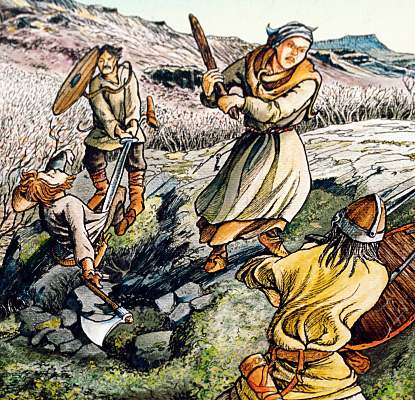 |
When Eyjólfur and his men attacked Gísli in overwhelming numbers, Gísli's wife Auđur stood by his side, armed with a club. In the first rush, Gísli killed Helgi by cutting him in two, while Auđur struck Eyjólfur so hard that he staggered back down the hill. Gísli turned to his wife and said, "I knew I had married well but never realized until now good the match was." |
|
After Gísli was killed by Eyjólfur, Eyjólfur visited Börkur and his wife, Ţórdís, who was Gísli's sister. Ţórdís did not want to offer hospitality to her brother's killer, but Börkur insisted. During the meal, Ţórdís recognized Gísli's sword lying on the floor by Eyjólfur's feet. She dropped a tray of spoons, and bending down to pick them up, she grabbed the sword and thrust up at Eyjólfur from below, giving him a major wound. Börkur seized Ţórdís, and she declared herself divorced from him on the spot. |
|
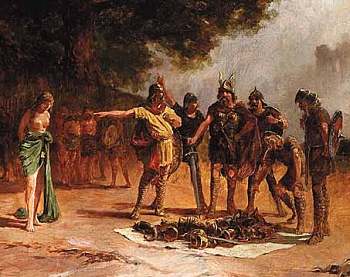 |
An exception to this exclusion was the violence against women during Viking raids. Women were routinely carried off as booty to be sold as slaves. An example is Melkorka from Laxdćla saga. Daughter of an Irish king, she was taken captive when she was 15 years old. Purchased by Höskuldur in Norway, she became the mother of Ólafur Höskuldsson (Olaf the Peacock). The medieval law book Grágás (K112) sets the purchase price for a concubine, a bondwoman used as a bedfellow. While not directly discussed, the stories imply that rape of women took place as part of the typical violence of a battle or raid. On the other hand, contemporary histories (such as the Annals of St-Bertin) suggest that Vikings were much less likely to commit rape during their raids than other European raiders of that time, such as the Carolingians. |
|
Rape is not commonly depicted in the sagas. One incident that has been interpreted as a rape is described in chapter 75 of Grettis saga. Grettir swam to shore during the night and entered the farmhouse at Reykir (shown to the right as it appears today). It was after the household had gone to bed, but Grettir knew he would be welcome there. In the night, his bedclothes fell off of him. In the morning, the first to rise were the farmer's daughter and a housemaid (griđkona). They saw Grettir lying naked, and the servant commented on how poorly endowed he was between his legs, running over to take a closer look and roaring with laughter. Grettir grabbed her and pulled her on to the bench while reciting two verses of scurrilous poetry. The servant cried out loudly, and the farmer's daughter left the room. What happened next is not related by the saga author, except to say that after the servant left Grettir, she did not taunt him again. |
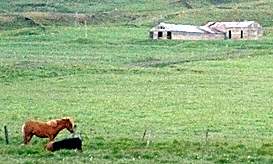 |
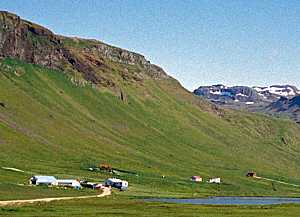 |
One final episode from the sagas serves to illustrate several of the attributes discussed in this article. In chapter 18 of Eyrbyggja saga, Ţorbjörn and his men arrived at Ţórarinn's home, Mávahlíđ (left, as it appears today) to search for horses which they believed were stolen by Ţórarinn. Since the search was illegal, Ţórarinn forbade a search and attacked Ţorbjörn's party. The fighting was fierce. Several men were wounded, but it seemed that one of Ţorbjörn's men, Oddur, could not be harmed by the weapons. Ţórarinn's wife, Auđur, and the other women on the farm threw clothing on the men's weapons to break up the fight. Ţorbjörn and his followers departed. |
After the fight, a severed hand was found. Ţórarinn thought that it was a woman's hand. He went into the house to find his wife in bed. He asked Auđur if she had been hurt, but she told him not to fuss. Then he saw that it was her hand that had been severed.
Outraged by this violence against his wife, Ţórarinn and his men chased after Ţorbjörn. Again, a battle raged, and Ţórarinn and his men were able to kill all but one of the men in Ţorbjörn's party. Only Oddur escaped, because, once again, weapons refused to harm him. He ran away from the battle.
Subsequently, Ţórarinn learned that Oddur was responsible for severing Auđur's hand. Oddur's mother, Katla, was a sorceress. It was she who used magic to make Oddur's tunic invulnerable to weapons. Ţórarinn led a party to the farm where Oddur was staying. Again, Katla used magic, this time to prevent Ţórarinn from seeing Oddur. Ţórarinn's mother told him what precautions to take against the magic. Ţórarinn returned to Oddur's farm and put a bag over Katla's head to prevent her from using magic. He seized Oddur and hanged him for being a party to magic and for his cowardice. Katla cursed them all, and they stoned her to death for being a sorceress.
|
|
©1999-2025 William R. Short |
The role of women in Norse society has been the topic of extensive research and scholarship in recent years. I feel unqualified to provide any more than this simple summary. I recommend that interested readers consult Jenny Jochen's text on the subject, listed in the references section.